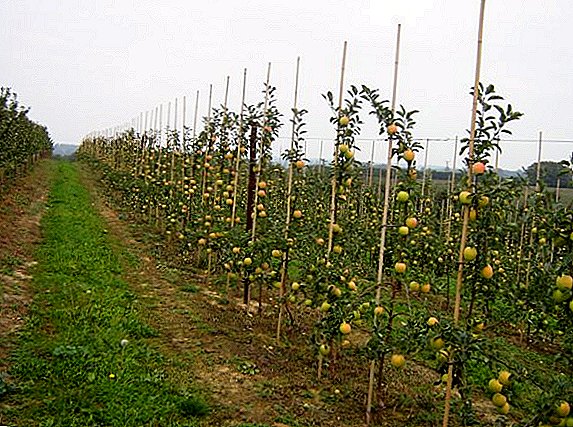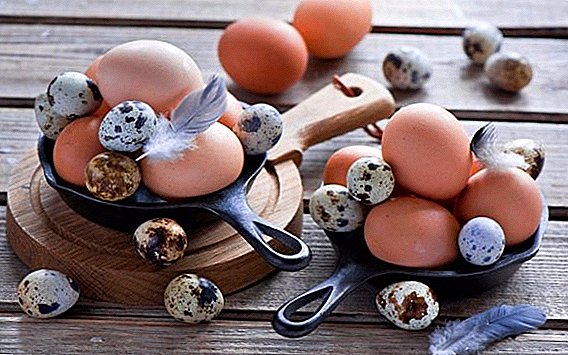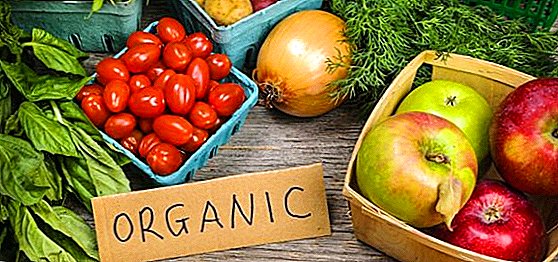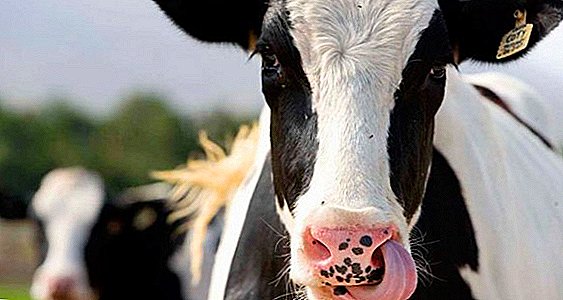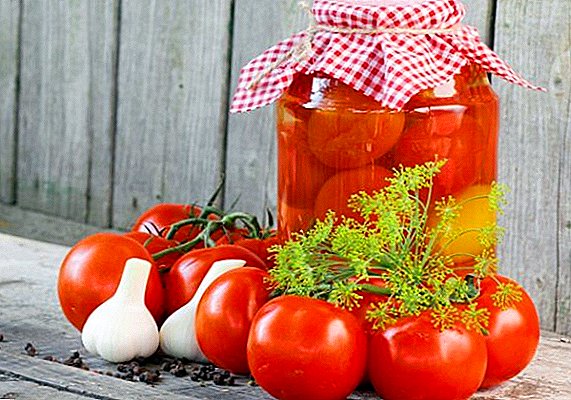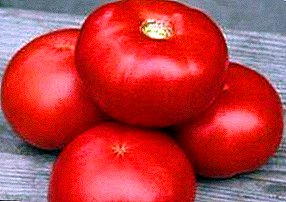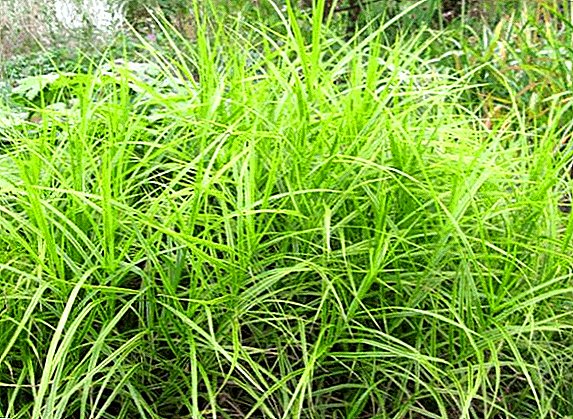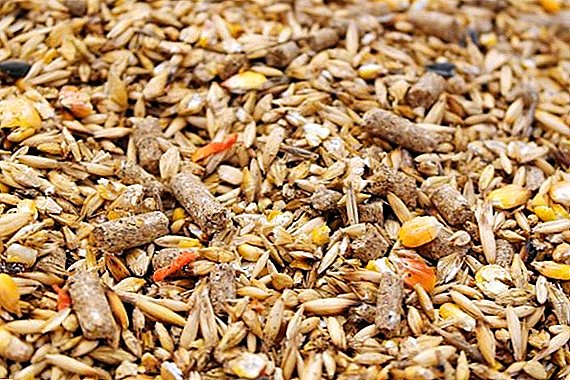 Livestock uses a variety of feed, but the main task for most farmers is not only good cattle health, but also a quick weight gain. For this purpose, both mixed feeds and concentrated nutrition, which has certain advantages, are used.
Livestock uses a variety of feed, but the main task for most farmers is not only good cattle health, but also a quick weight gain. For this purpose, both mixed feeds and concentrated nutrition, which has certain advantages, are used.
What is it, and what subspecies can be divided into concentrated food - read on.
What are the
Concentrated plant foods are represented by a homogeneous product with a mixed structure. In its composition there are legumes and cereals, cereals, as well as waste from the plant and animal industries, which have already passed the stage of grinding and cleaning.
In comparison with other varieties, this food has a higher content of beneficial substances, including fiber. It can be fed dry or steamed with chopped hay or straw. Consider all the main components of such feeds more closely.

Cereal grains
Corn, barley, wheat, oats, rye and other cereals are the main components of high-energy feed products. About 2/3 of the whole mass of grain is starch, which is almost completely digestible in the body.
A significant amount of easily digestible carbohydrates ensures high nutritional value of cereal grains, which is in the range of 0.95-1.35 feed. units on 1 kg. At the same time, the cereal protein is characterized by low bio-value.
Did you know? The bamboo family belongs to the family of cereals, but in comparison with the usual low-growing plants, it is a real giant, because some of its varieties grow to 3800 m!

Seeds of legumes
In comparison with previous seeds, more protein and lysine are present in raw legumes (the main limiting amino acid in pigs nutrition), and the main representatives of this group are peas, soybeans and lupins, although sometimes there are fodder containing wiki, lentils, fodder beans.
Peas well suited for feeding pigs, as it contains 220 g of protein and 15 g of lysine per kilogram. In terms of biological value, it is close to soybean meal and meat meal, which contain about the same amount of protein. Most often in concentrated feed for cattle included about 10% of peas.
Find out what is related to legumes.
Soy It is considered the most valuable bean, because it contains up to 33% of raw protein - the most complete of all plant species. 1 kg accounts for 21-23 g of lysine, which brings soy protein closer to the animal protein component.
Nevertheless, anti-nutritional components are present in soybeans, which is why the use of soybean in concentrated mixtures and compound feeds is permissible only after they have been fully cooked: for example, roasting or extruding.
If you grow pigs, then you should pay attention to feed with a high content lupine. This is an excellent protein element, which is especially good to use when feeding animals to potatoes.

Waste technical production
After processing various plant products, a lot of waste remains, which can also be used for feeding cattle and pigs. For example, the cake and meal, remaining after processing the grains of soybeans, sunflower, cotton, flax and peanuts, contain up to 31-45% of crude protein.
Dried beet pulp - a valuable product for ruminants, so it is introduced into the diet of young cattle as an alternative to grain (usually up to 10% by weight is used).
Find out how sunflower cake and meal differ.
One of the types of waste technical production is molasses - hydrocarbon nutritional mixture, in which there is about 50% of sugars and 10% of nitrogenous substances (for the most part non-protein species). High concentration of sugars contributes to better feed digestibility.
If possible, you can use the waste of alcohol or breweries, for example, pellet. In the dried state, this substance will be a valuable component of any compound feed that can be used both for feeding pigs and for saving grain.
 Beet pulp (granule)
Beet pulp (granule)
Types of processing
All components of concentrated feed should be pretreated, which can improve their quality and contribute to the optimal interaction with other components. There are several options for such processing, we consider the most popular ones.
Shredding
This preparatory stage is mandatory for legumes and cereals, because only crushing or grinding can destroy the solid shell, thereby facilitating the chewing of food by animals. In addition, crushed grain is much easier to combine with other types of nutrient mixtures.
The level of grinding will depend on the age and type of the particular animal. So, in infancy, it is desirable to feed calves and piglets with well chopped grain (not more than 1 mm), but for adult representatives the particle size can be 1.5-2 mm. Crushed grains give all kinds of animals, combining them with root crops, silage and chopped straw.
Important! When grinding grain crops, part of the starch is transformed into monosaccharides, thereby giving the grain a sweetish aftertaste. However, due to the denaturation of the protein, the digestibility of the protein and the possibility of obtaining amino acids are slightly reduced.
 Crushed corn
Crushed corn
Malting
This type of processing is used to improve the taste properties of cereals (mainly barley, wheat and corn), so that animals are much more willing to eat the proposed feed. The essence of the process is reduced to the impact on the grain of high temperatures, with the result that starch is sugared and better absorbed.
This is ideal for feeding suckling piglets and weaners for fattening (using malted grain, you can replace up to 50% of the total amount of concentrated feed).
It is interesting to learn how to make a feeder for pigs with your own hands.
At home, such training can be carried out simply by putting a portion of the concentrate for several hours in a trough or a boiling water kettle (+ 85-90 ° C). In this case, for 1 kg of feed should be about 1.5-2 liters of water, and soaked grain, it is desirable to constantly stir.
To keep the food warm for as long as possible, it is filled with a 5-centimeter layer of dry concentrated mixture. The highest-quality result of anti-aging is obtained at a processing temperature of + 60-65 ° C.
Malting feed: video
Yeast
With the help of yeast, it is possible to significantly increase the intake of protein into the organism of animals. During processing, the grain is enriched with protein, which has a high biological value (its amount increases almost twofold).
This component contains all the essential acids and is 90-95% absorbed by the body, which saves up to 25% of concentrated feed. In addition, the use of such concentrates has a beneficial effect on the health of animals, at the same time increasing their productivity by 15-20%.
Familiarize yourself with the rules for preparing hay-type feeds.
Yeast can be carried out by boil, bezoparny and fermenting methods, but in any of them yeast and warm water are used, in which the grain is soaked.
 Feed Yeast
Feed Yeast
Extrusion
This option of pretreatment of feed is rightly considered the most effective, as it contributes to significant transformations in the grain structure, changes the physicochemical properties of the constituents of protein, starch, fiber and some other nutrients.
The essence of the extrusion process lies in the mechanical impact (for example, compression or friction) on the grain, which appears at the moment of its movement through the extruder press and “explosion” when the homogeneous mass is ejected from the machine (the reason is a sudden change of pressure).
Extrusion increases the biological value of grain protein legumes, partially destroys cellulose and starch complexes, turns molecules into dextrins, increasing the amount of nutrients and making them much more accessible to animals.
Processed cereals have a pleasant smell of baked bread and a no less pleasant taste, which during the regular use of mixed feeds contributes to an increase in the productivity of agricultural animals and, above all, pigs.
Did you know? If you believe the archaeologists, then wheat is one of the most ancient cultures on our planet. Back in 1904, under Ashgabat, grains were found, which at that time, according to preliminary estimates, were about 5 thousand years old.
Feeding ducks extruded feed: video
Micronization
This process involves the swelling of the grain with a consistent flattening, drying and changing the structure of starch. It is possible to achieve similar results by heating in an infrared oven to + 100 ... +120 ° C for 20-40 seconds.
As a result of exposure to high temperatures, protein is damaged and the structure of carbohydrates changes, which as a result has a positive effect on animals. In addition, micronization allows reducing the number of microorganisms by a factor of 5-6, and if the treatment is extended to 45 seconds, then proteolytic bacteria will disappear.
That is, all concentrated feed almost completely get rid of granary pests.
Learn how to deal with barn weevil.
 Micronized Cornflakes
Micronized Cornflakes
Concentrated feed
Not all concentrated feed is equally suitable for poultry, pigs or cattle, so before buying a particular composition, it will be useful to familiarize yourself with the requirements of each individual category of farm animals.
For birds
Grain is the main component of any concentrated diet, but its share may be completely different. The feed rate can be calculated based on the following data:
For chickens the best is the ratio of components:
- corn - 50% of the total mass of the feed;
- wheat - 15-20%;
- cake or meal - about 20%;
- fat supplements and chalk - the remaining 10%.
Important! For the most part, all the trace elements necessary for animals (for example, zinc or manganese) are contained in cereals, while the main source of vitamins is hidden in beans.
 Feeding hens
Feeding hens
For ducks The following values are optimal:
- corn - 50%;
- milled or grain wheat - 20%;
- oats or barley - about 15%;
- peas - 10%;
- bran, cake or yeast - no more than 5%.
Learn the features of feeding ducks at home.
If you grow geese it is better to focus on these numbers:
- corn - no more than 20%;
- wheat - 15%;
- barley - 20%;
- oats - 25%;
- wheat bran - 19%;
- salt - 1%.
Get acquainted with the proper nutrition of goslings from the first days of life.
For turkeys components of concentrated feed should be distributed as follows:
- corn - 35%;
- barley - 35%;
- flour (vegetable or animal character) - 15%;
- wheat - 10%;
- sunflower meal - 3%;
- limestone - 2%.
Learn how to grow broiler turkeys at home.Sometimes it is possible to deviate a little from these requirements, but in most cases each category of domestic animals should receive food in precisely this ratio of nutrients.
 Feeding turkeys
Feeding turkeys
For cattle
The use of concentrated feed for breeding cows can significantly increase the amount of milk and its nutritional value, and not to mention the higher taste characteristics of meat.
Bean components have a positive effect, where a large amount of protein is contained, and 20-30% (in a quiet period) and up to 60% for cows with regular milk yield are considered the norm of the used cereals.
Learn how to properly fatten cattle.
Cereals can be used both dry and in a mushy state, after mixing with water. The remaining place in the concentrates may be occupied by soybeans, alfalfa, barley and oats.

For pigs
Due to the rich composition of concentrates (especially the presence of protein and starch), their use is appropriate when breeding pigs whose meat becomes very tender and tasty.
Up to 70% of cereals can be included in the diet of these animals by comparing them with the other components in this ratio:
- barley - 40%;
- wheat - 30%;
- oats - 10%;
- corn - 10%;
- peas - 10%;
- salt - teaspoon;
- chalk and vitamins - at the discretion of the owner.
Learn all about feeding pigs: how to make the best diet and choose the right technology.
Before you give such a mixture of pigs, cereals, it is desirable to grind well and only then add to them the other components. After stirring the mash in boiling water, it is infused for the next 12 hours before serving.
Nutrient absorption in the case of pigs is about 90%, so if you want to improve the quality of fat, you can use carbohydrate grains, adding them to legumes for more tender meat. The deficiency of lysine and some amino acids in concentrated feed can be replenished with meat and bone meal and production of meat residues that are mixed with the main feed.

For goats
Unlike cattle, pigs and poultry, goats do not often need concentrates, which means that similar foods are used as an additive, normalizing the level of nutrients in their bodies. The optimal amount of grain in this case should be no more than 30%, otherwise there is a likelihood of problems with the gastrointestinal system of animals and their obesity.
When feeding goats in their diets usually include oats, meal, barley, corn, oilcake and bran, while dairy goats are also fed with alfalfa hay.
Check out the tips and recommendations for beginner goats, rules for keeping and feeding dairy goats.
Concentrated feed can be combined with feed mixtures, since dry grain is not as interesting to animals as mash.
The permissible composition of concentrated nutrition for goats is as follows:
- grain - 30%;
- oatmeal - 20%;
- bran (preferably wheat) - 22%;
- ground wheat - 9%;
- sunflower meal - 10%;
- yeast - 5%;
- premixes - 3%;
- salt - 1%.
Before feeding the animal, all components should be mixed well and insisted in boiling water for about 12 hours.

Did you know? Goat milk is absorbed by the human body much faster than cow's milk, so it is recommended for people suffering from intolerance to the latter. Nevertheless, approximately 2/3 of the modern population have never tried this product at all.
For sheep
The digestive system of these animals in many ways resembles the location and characteristics of the organs in the goat body, so you should not often use concentrated feed. In this case, the rate of their issuance is about 200 g per female and 700 g per male per day, and in order to achieve maximum balance of protein, fiber and carbohydrates, you can mix corn, legumes and oilcake.
Sheep especially likes corn concentrates, although the following component distribution will be no less nutritious:
- oats - 26%;
- barley - 25%;
- wheat bran - 23%;
- sunflower meal - 13%;
- yeast - 8%;
- defluorinated phosphate - 3%;
- premixes - 1%;
- salt - 1%.
Learn how to feed sheep at home.
These components can be replaced by others, the main thing is that they remain equivalent in their components. So, the most appropriate alternative would be corn, beans, cake.

For horses
Of all the components of the concentrates, these animals prefer oats, in any form: hay, grain, meal, or oilcake. Horses also will not give up barley and wheat, which, unlike oats, must necessarily be combined with mixed feeds.
The required amount of grain is determined on the basis of physical activity and lifestyle of the animal: oats support and promote energy production throughout the day, rye and barley will be an excellent nutritional supplement to other products, and wheat will be appropriate if you need to quickly gain weight.
A horse should receive about 30% of the concentrate per day, but these values are very approximate: a lot depends on the life rhythm of each individual animal. In the absence of load, 20% of concentrated feed is sufficient, with light work (for example, short riding) - 30%, with cart riding and dressage - 40%, with medium work - 50%, with hard work - 60%, with speed jumps or races - 70% of the total amount of food.
Important! The peculiarity of the issuance of feed when feeding horses is the need to crush them, because the whole components are poorly absorbed by the horses' stomach. It is advisable to steam rye or barley in water before swelling in order to exclude the possibility of colic in animals.

As an acceptable option, horses can be prepared with nutritious swill, mixing in equal proportions milled oats with food yeast and pouring it all with boiling water. With the immediate issuance of the mixture should be completely cooled.
Ознакомьтесь с правилами разведения лошадей в домашних условиях.
As you can see, concentrated feed can be a great helper for a farmer when feeding any kind of domestic animal life. The main thing to remember is the requirements of each animal to the number of certain components, and the above figures will be able to remind you of this.



